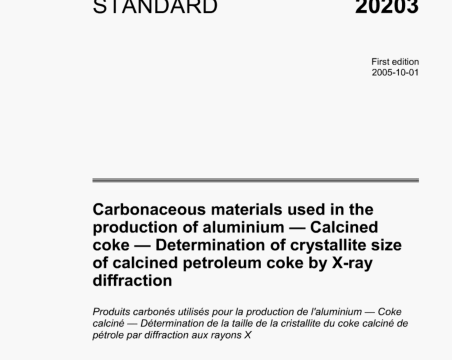ISO 20203 pdf download – Carbonaceous materials used in theproduction of aluminium -Calcinedcoke- Determination of crystallite sizeof calcined petroleum coke by X-ray diffraction.
3 Principle
A packed sample pulverized to less than 75 urn is subjected to a monochromatic X-ray beam and rotated to produce a diffraction pattern under speafic conditions. The lecation and shape of the peak with MI (002) at d • 0,335 nm.s used to calculate L by manual interpretation of the peak or by corn puter simulation,
4 Apparatus
4.1 X-ray powder diffractonioter equipped with an X-ray source set for Cu-Ka radiation, a
monochrornator or filter for restricting the wavelength range, a sample holder, a radiation detector, a signal processor, and readout (chart or computer memory). The diffractometer shal be capable of rate scanning at 11 min or incrementally step scanning at 0,T/step.
4.2 Sample holders, as speafied by the manufacturer of the dltfractometer, that enable packing of a pulverized sample of sufficient heiit to expose a level, smooth surface to the X-ray beam,
4.3 Briquetting press, capable of generating pressures up to 70 UPa.
4.4 Compressible aluminum cap.. used as a support for producing a briquetled sample.
4.5 SIlicon or quartz sample, of reference material quality suitable for calibrating the dilfractometer,
NOTE These rnatenals are usually avadable from national relerence orgarizations e.g the National Institute ci Standards and Technology in USA.
5 Reagents and materials
Use only reagents of recognized analytical grade and only distilled water or water of eqjvalerit pLaity (see (1), (2) and (3) In the Bibliography).
5.1 Acetone.
5.2 Polyethylene glycol, approximate molecular weight of 200.
53 Binding agent, prepare a solution of polyethylene glycol end acetone, so that the proportion of polyethylene glycol In the solution, expressed as a mass fraction (i.) by percentage of the total composition.
15 %. by addIng 159 of polyethylene glycol to 85 g of acetone.
6 Sample preparation
6.1 General
For recommended practices for obtaiing. handbng and preparing coke samples. refer to ISO 6375 (5),
Reduce and divide the gross sample to obtain a Laboratory analysts sample.
Divide. by riffling, a m,nmum 011009 from the laboratory analysis sample.
Crush 100 go? the teat sample such that 98 % will pass through a 75 pm (No. 200) sIeve.
6.1.1 Any of the packing techniques ksted in 6.2 may be used for packing the sample into the X-ray diffractometer specimen holder:
6.2.2 Front-fill technique
Place a confining flng over the round sample holder and fill the holder cavity and ring wdh sample. The nrig will initially overfill the sample holder. Work the sample into the entire cavity and ring. Scrape the excess off with a glass plate or spatula. Press down using a flat glass slide. Remove any excess material on the front face of the holder. Repress the sample with the glass slide while turrwng dockwise and anticlockwise. Continue until the sample is level with the holder face. Place the sample in the dlffractometer holder.
6.2.3 Side-loadIng technique
Pack the sample. Clamp a glass slide over the top face to form a temporary cavity wall With the holder in a vertical position. dflft the powdered sample into the end opening. If necessary, use a cardboard pusher cut to fit the cavity, to ligl’itiy compress the sample so it mll remain in the cavity. Return the holder to a horizontal position and carefully remove the glass slide Place the sample in the diffrac*ometer holder,
6.2.4 Brlquetting technique
Weigh out 4,Og of the sample onto a watch glass and pipette exactly 3 ml of the bnding agent onto the sample and mix thoroughly with a spatula Place the sample under an infrared-heat lamp and allow the acetone to evaporate. Typically, about I or 2 mm will be required to ebminale the acetone odour from the sample. Break up the caked sample with a spatula and transfer to an aluminLirn cap whose c5ameter is compatible with the sample holder of the diffractometer, Place the cap in a bnquettinq press and press at 48 MPa. Transfer the pelletized sample to the sample holder and insert into the difiractometer for analysis.
7 Calibration
7.1 Ensure that the d.ffractometer is in correct mechanical and optical alignment and that intensities have been maximzed through the procedures descabed in the instrument manufacturers documentation. A service engineer or in-house technician who ha been well instructed in the correct abynment procedures suggested by the manufacturer best accomplishes this.
ISO 20203 pdf download – Carbonaceous materials used in theproduction of aluminium -Calcinedcoke- Determination of crystallite sizeof calcined petroleum coke by X-ray diffraction
